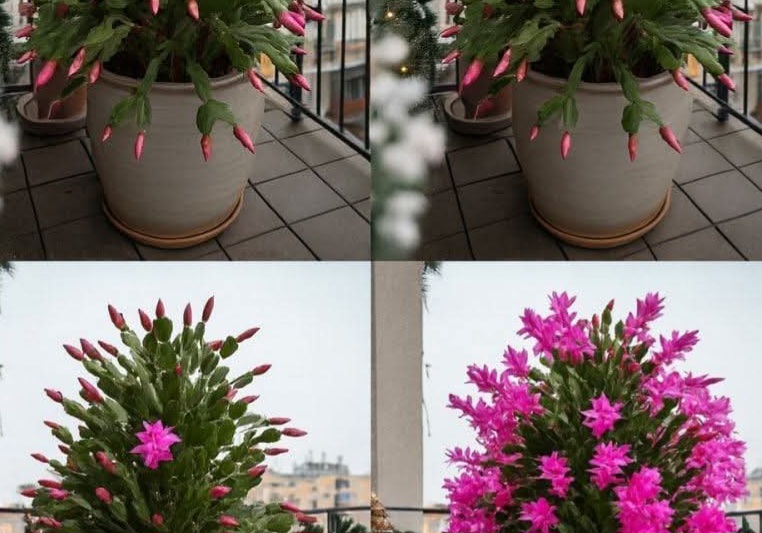How I Get My Christmas Cactus to Bloom Nonstop — The Secret Method Revealed
Introduction
A Christmas cactus in full bloom is one of the most heart-warming sights of the holiday season. Its cascading stems and vibrant pink, red, or white flowers bring cheer to any home. But many people struggle to get their Christmas cactus to bloom at all—let alone nonstop.
The method below reveals the simple yet highly effective routine that encourages continuous blooming, keeping your cactus glowing long after the holidays.
Ingredients & Quantities (Plant-Care Version)
(Since this is not a food recipe, “ingredients” refer to the exact materials needed for the blooming method.)
1 healthy Christmas cactus (Schlumbergera truncata or Schlumbergera bridgesii)
1 well-draining pot with drainage holes
1 bag cactus/succulent soil mix
Filtered or rain water (as needed)
A bright, indirect light location
A dark room or box for the blooming cycle
Cool temperature environment (50–60°F / 10–15°C)
Balanced fertilizer (10-10-10 or 15-15-15)
Optional: Humidity tray
Instructions — The Secret Nonstop Blooming Method
1. Replicate Natural Conditions
Christmas cacti bloom when they experience:
✔ Short days
✔ Long nights
✔ Cool temperatures
✔ Slight dryness
This mimics the Brazilian rainforest winter cycle.
2. The 6-Week Bloom Trigger Routine
For 6 weeks before desired bloom time:
1. Give your plant 14 hours of darkness daily
Place in a closet
Or cover with a breathable dark cloth/box
Uncover each morning so it gets 10 hours of indirect light
2. Drop the temperature
Keep it between 10–15°C (50–60°F).
This is crucial for bud formation.
3. Reduce watering
Only water when top 1 inch of soil feels dry.
Do NOT overwater—buds will fall off.
4. Stop fertilizing during the bud-forming phase.
3. Once Buds Appear
Move plant back to a bright indoor spot (never direct sun).
Resume gentle watering.
Begin light fertilizing every 2 weeks.
Maintain moderate humidity.
4. For Continuous Nonstop Blooming
After the first bloom:
Rest the plant for 2–3 weeks with less water.
Then start the dark–light cycle again for another bloom.
Christmas cacti naturally repeat blooming if the cycle is consistent.
Origin & Cultural Significance
The Christmas cactus is native to the Brazilian coastal rainforests, where it grows on trees as an epiphyte.
It became culturally significant in the 19th century when Europeans discovered its ability to bloom during the winter holidays.
Today it symbolizes:
✨ Hope during the dark season
✨ Family traditions (often passed down through generations)
✨ Renewal and gratitude
Many families treasure Christmas cacti as heirloom plants surviving for decades.
Description of the Plant & Result
A well-cared-for Christmas cactus produces:
Delicate, multi-layered flowers
Colors ranging from fuchsia to coral to pure white
Arching stems that display blooms like a festive fountain
When following this method, the plant can bloom:
In December
Again in winter
Sometimes even in early spring
Giving the appearance of “nonstop” blooming.
Optional Additions
Humidity tray: Helps prevent leaf shriveling.
Grow light: Use if you lack bright indirect light.
Self-watering pot: Only if you naturally under-water.
Orchid bark mix: Improves drainage and mimics its natural habitat.
Epsom salt feed (once a month): Provides magnesium for deeper color.
Tips for Success
Never expose to direct sunlight
Avoid drafts and sudden temperature changes
Never move the plant after buds appear—buds will drop
Don’t overwater during the resting phase
Use a pot only slightly larger than the root system
Nutritional Information (Plant-Safe Perspective)
(Not for eating, but describing nutrient needs.)
Nitrogen: Supports stem growth
Phosphorus: Essential for bloom production
Potassium: Strengthens the plant for continuous cycles
Magnesium: Boosts flower vibrancy
Calcium: Supports root and tissue strength
Conclusion
Getting a Christmas cactus to bloom nonstop isn’t luck—it’s understanding how the plant naturally thrives. With cool temperatures, controlled lighting, and careful watering, your cactus can reward you with show-stopping flowers again and again.
Recommendation
Start the blooming cycle in late September for December flowers.
Then repeat the cycle in January or February for secondary blooms.
This technique ensures a reliable and stunning flowering display year after year.
Embracing Healthful Indulgence
Just like a comforting recipe you can’t resist, tending to a Christmas cactus becomes its own form of emotional nourishment. The slow, intentional care invites peace, patience, and joy. Watching those buds open is a reminder that beauty often grows during the quiet moments.
Embrace this gentle routine.
Let your cactus—and your spirit—bloom freely.
